- Joined
- Jun 28, 2010
- Messages
- 32,109
- Reaction score
- 42,326
https://allthatsinteresting.com/worst-execution-methods
Boiling To Death
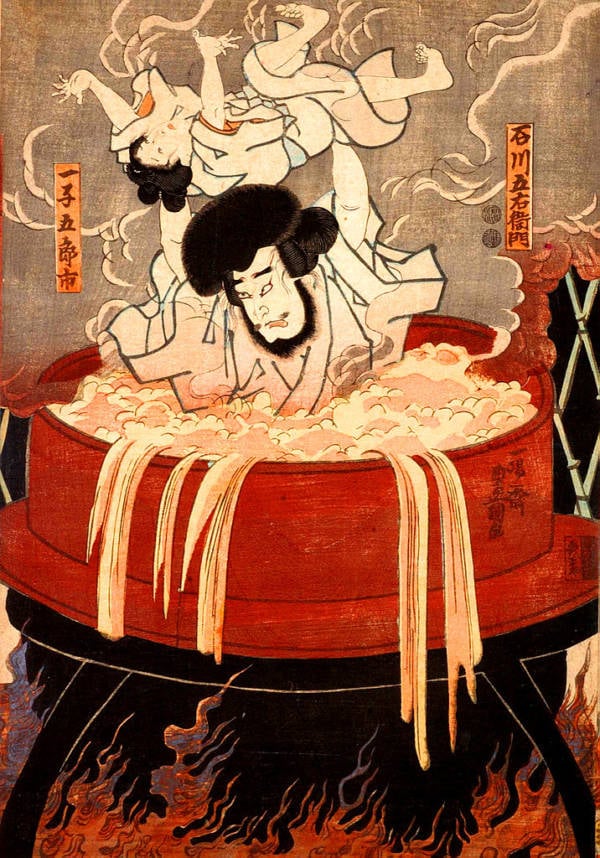
A slow and agonizing punishment, this method traditionally saw the victim gradually lowered — feet-first — into boiling oil, water, or wax (although uses of boiling wine and molten lead have also been recorded).
If the shock of the pain did not render them immediately unconscious, the person would experience the excruciating sensation of their outer layers of skin, utterly destroyed by immersion burns, dissolving right off their body, followed by the complete breakdown of the fatty tissue, boiling away beneath.
It seems safe to assume that such a horrendous fate, one of the worst execution methods ever devised, would be reserved for the foulest of murderers, but historical documents refute this.
The Blood Eagle

A technique ascribed to ancient Norse warriors, the blood eagle mixed brutality and poetic imagery in a way that only the Vikings could. First, the victim’s back would be hacked open and the skin ripped apart, exposing the spinal column.
The ribs would then be snapped from the spine and forcibly bent backwards until they faced outwards from the body, forming a pair of bloody, shattered eagle’s wings. As a horrifying finale, the lungs would then be pulled from the body cavity and coated with stinging salt, causing eventual death by suffocation.
There is some question as to whether this technique was ever actually used as the only accounts come from Norse literature.
Several scholars claim that the act we know of today is simply a result of poor translating, and misunderstands the strong association of the eagle with blood and death in Norse imagery. That said, every account is consistent in that in each case, the victim is a nobleman being punished for murdering his father.
The good news for any poor soul who might have suffered this indignity? The agony and blood loss from the initial wounds would probably have caused them to pass out long before the lungs were removed from their bodies.
Impalement
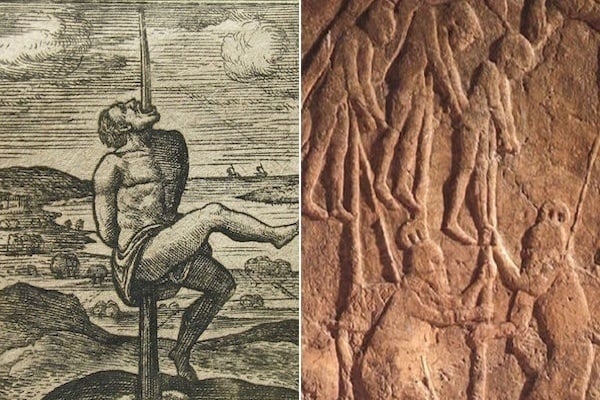
Most famously used by Vlad the Impaler, 15th-century ruler of Wallachia (in present-day Romania) and inspiration for Count Dracula, the act of impalement has a long, grim history. While images tend to depict people skewered through the midsection and then held aloft — in a manner that would almost certainly bring about a rapid death — the real process was a much longer, horrifically drawn-out ordeal.
Traditionally, the stake would be partially sharpened and planted, point up, in the ground. The victim would then be placed over the spike as it was inserted partway into the rectum or vagina.
As their own body weight dragged them further onto the pole, the semi-greased wooden stake would force its way up through their body, piercing organs with an agonizing slowness as it eventually penetrated the entire torso, finally tearing an exit wound through the skin of the shoulder, neck or throat.
The earliest records of the torture come from 1772 B.C. in Babylon, where King Hammurabi ordered a woman be executed in this way for killing her husband. But its use continued until as recently as the 20th century, when the Ottoman government employed the technique during the Armenian genocide of 1915-1923.
According to some accounts, it could take the victim — exposed, bleeding, and writhing in tormented agony — as long as eight whole days to die.
Keelhauling
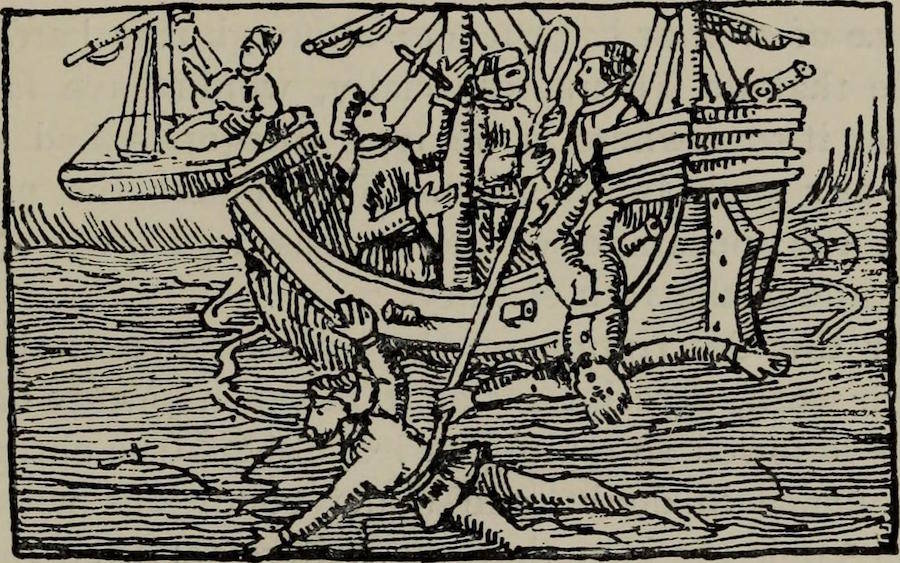
Walking the plank might not be the most pleasant of deaths, but it seems moderately more humane than the other favored maritime punishment of keelhauling.
A punishment that often ended in death due to the severity of the wounds sustained (or was simply carried out until the point of death), it saw the victim, legs weighted and suspended from a rope, dropped from the bow of the ship and then rapidly pulled underwater along the length of the hull — and over the keel (the beam that runs longitudinally down the center of the underside of the ship), hence the name — to the stern.
In the age of wooden sailing ships, the hull of a vessel would normally be coated in a thick layer of barnacles, whose shells could be rock hard and razor sharp.
As the drowning sailor was yanked relentlessly through the salt water, these protrusions would strip the skin from his body, gouging out raw chunks of flesh and even, by some accounts, tearing off whole limbs or severing the head.
If the sailor was still alive, they might be hung from the mast for 15 minutes before going in again. In some cases, the victim would have an oil-soaked sponge — containing a breath of air — stuffed into their mouth to prevent a “merciful” drowning.
Employed mostly by the Dutch and the French from the 1500s until it was abolished in 1853, accounts of its use date back as far as Greece in 800 B.C.
The Roman Candle
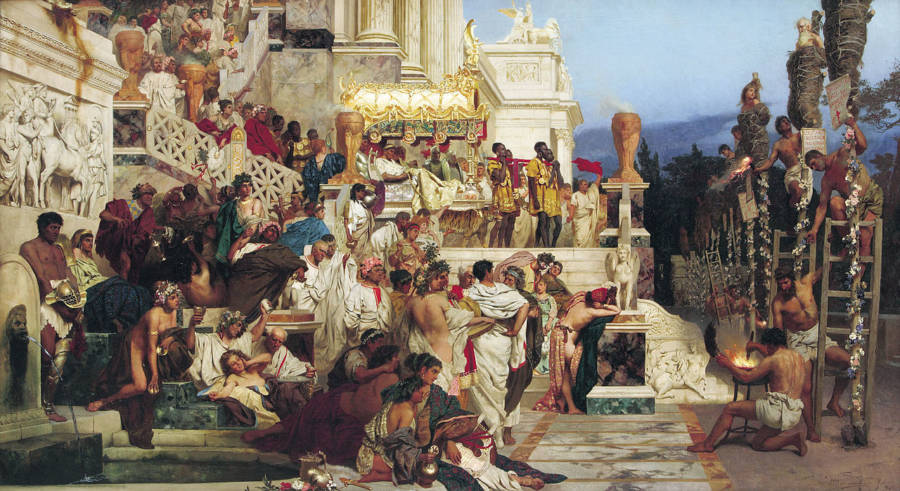
Many of the very worst execution methods ever devised involve fire — from burning witches at the stake in medieval Britain to roasting criminals alive in the searing metal insides of the brazen bull in Ancient Greece — but few match the sheer lack of humanity as the Roman Candle.
A rumored favorite of the mad Roman Emperor Nero, this method saw the subject tied to a stake and smeared with flammable pitch (tree or plant resin), then set ablaze, slowly burning to death from the feet up.
What sets this above the many other similar methods is the fact that the victims were sometimes lined up outside to provide the lighting for one of Nero’s evening parties.
Being Hanged, Drawn, And Quartered
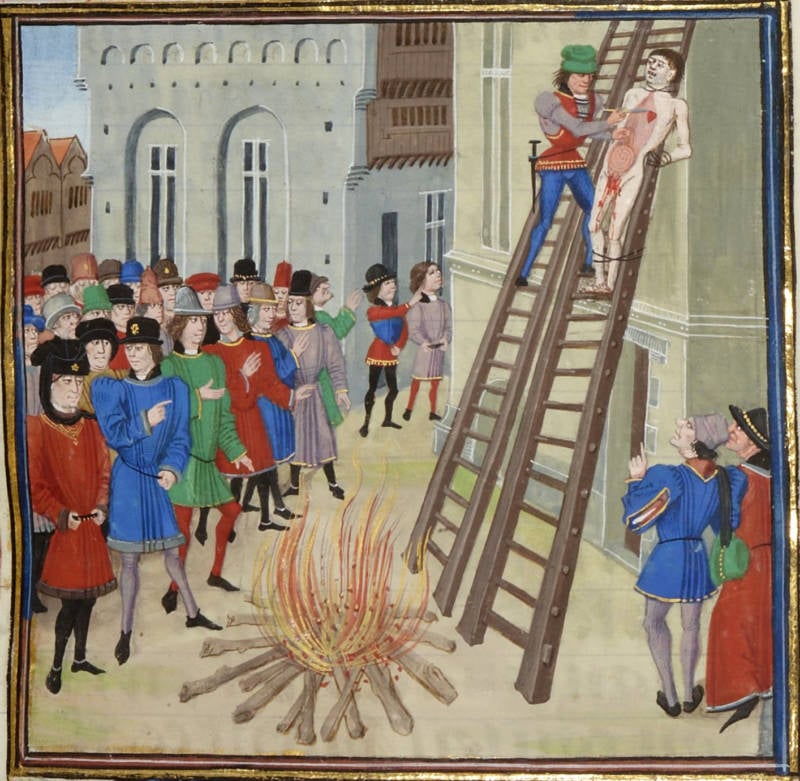
First recorded in England during the 13th century, this unusually extreme — even for the time — mode of execution was made the statutory punishment for treason in 1351. Though it was intended to be an act of such barbarous severity that no one would ever risk committing a treasonous act, there were nevertheless plenty of recipients over the next 500 years.
The process of being hanged, drawn and quartered began with the victim being dragged to the site of execution while strapped to a wooden panel, which was in turn tied to a horse.
They would then experience a slow hanging, in which, rather than being dropped to the traditional quick death of a broken neck, they would instead be left to choke horribly as the rope tore up the skin of their throat, their body weight dragging them downwards.
Some had the good fortune to die at this stage, including infamous Gunpowder Plot conspirator Guy Fawkes, who ensured a faster death by leaping from the gallows.
Once half strangled, the drawing would begin. The victim would be strapped down and then slowly disemboweled, their stomachs sliced open and their intestines and other major organs hacked apart and pulled — “drawn” — from the body.
The genitals would often be mutilated and ripped from between their legs. Those unlucky enough to still be alive at this point might witness their organs burned in front of them, before they were finally decapitated.
Once death had finally claimed them, the recipient’s body would be carved into four pieces — or “quartered” — and the parts sent to prominent areas of the country as a warning to others.
The head would often be taken to the infamous Tower of London, where it would be impaled on a spike and placed on the walls, “for the mockery of London.”
Rat Torture
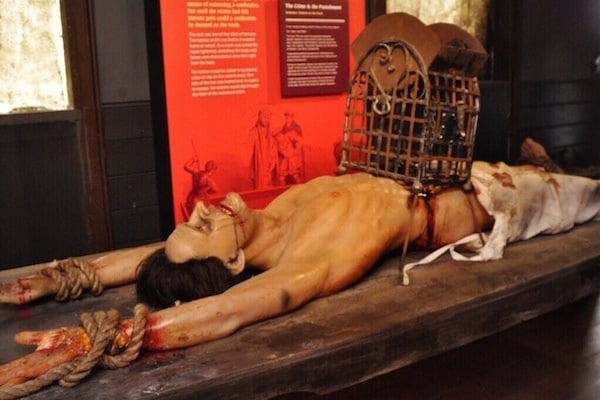
As recently depicted in Game Of Thrones, rat torture is a method ingenious in its disgusting simplicity. In its most basic form, a bucket containing live rats is placed on the exposed torso of the victim, and heat applied to the base of the bucket.
The rats, crazy with fear from the heat, tear and gnaw their way into the abdomen of the victim, clawing and ripping through skin, flesh, organs, and intestines in their quest to escape.
Possessing the most powerful biting and chewing motion of any rodent, rats are able to make short work of a human stomach. Along with the unimaginable pain, the victim would also suffer the sick horror of feeling the large, filthy creatures writhing around inside their guts as they died.
While associated with Elizabethan England — where the Tower of London was said to have housed a “Dungeon of Rats,” a pitch black room below high water mark that would draw in rats from the River Thames to torment the room’s inhabitants — the practice has been used far more recently.
General Pinochet is said to have employed the technique during his dictatorship of Chile (1973-1990), while reports from Argentina during the National Reorganization Process in the late 1970s and early ’80s claimed victims were subjected to a version in which live rats — or sometimes spiders — were inserted into the subject’s body via a tube in the rectum or vagina.
Bamboo Torture

Forcing thin shards of bamboo under the fingernails has long been cited as an interrogation method, but bamboo has been used to creatively — and slowly — execute a person, too. Allegedly used by the Japanese on American prisoners of war, it saw the victim tied down to a frame over a patch of newly sprouting bamboo plants.
One of the fastest-growing plants in the world, capable of up to three feet of growth in 24 hours, the sharp-tipped plants would slowly pierce the skin of the victim — and then continue to grow. The end result was death by gradual, continuous, multiple impalements, the equivalent of being dropped on a bed of sharpened stakes in terrible slow motion.
Despite the practice having roots in the former areas of Ceylon (now Sri Lanka) and Siam (now Thailand) in the 19th century, there are no proven instances of it having been used during WWII.
It’s certainly possible, however, and it has been shown that the technique, among the worst execution methods ever, works: A 2008 episode of MythBusters found that bamboo was capable of penetrating a human-sized lump of ballistic gelatin over the course of three days.
Flaying

Flaying — better known as “skinning alive” — has a long and grotesque history. Records of the practice exist as far back as the Neo-Assyrian Empire (beginning in 911 B.C.), but it has cropped up in most civilizations at one time or another, including Medieval Europe (where it tended to be used as a punishment for traitors) and in the ritual human sacrifices made by the Aztecs in Mexico (the Aztecs, at least, are believed to have skinned the body after the sacrifice had been made).
Various techniques have been utilized in the many different cultures in which flaying has been employed, but the basis remains the same: Slowly, excruciatingly slicing the skin from the body while keeping the victim alive for as long as possible (and when feasible, removing the skin intact).
Carvings from the Assyrian period show the process beginning with incisions to the thighs or buttocks, while the European method — pictured above — shows it starting with the skin being torn from the feet and lower legs. Chinese Emperors Sun Hao, Fu Sheng, and Gao Heng ordered the skin to be peeled from their victims’ faces.
Death would normally come as a result of massive blood loss and shock, but in the unfortunate cases where expert flayers were used, the victim could be kept alive in a state of perpetual agony for several days before finally succumbing to their hopelessly infected wounds.
Scaphism

For sheer, delirious, nauseating horror, scaphism may be one of the worst execution methods ever devised. Practiced by the Ancient Persians, starting around 500 B.C., it saw the victim placed inside a hollowed-out log or narrow boat, their hands and feet tied to each end.
The victim was then forced to ingest a mixture of milk and honey until they uncontrollably voided their bowels, at which point their skin was smeared with more milk and honey before they were left exposed in the sun and surrounded by their own feces and vomit.
It was at this point that the insects would descend. Stinging and biting insects like wasps and ants would torture the victim, but worse, others would crawl inside the unprotected orifices of the subject and lay eggs, eating them alive from the inside out.
With the ration of milk and honey — and sometimes water — repeated at daily intervals, the victim had little chance of dying of thirst or hunger.
Instead, they succumbed to tortured madness, experiencing the agonizing, nightmare crawl of thousands of insects on their skin, burrowing into their eyes and ears and nose, filling their mouths, while worms and parasites bred in the filth at the bottom of the boat and squirmed up into their bowels.
Death would eventually be caused by a combination of exposure and the massive infections caused by both the insects, and the fecal matter smeared into the wounds. One account of such an execution by the Greek historian Plutarch claimed that it took the victim 17 whole days to die.
Brazen Bull
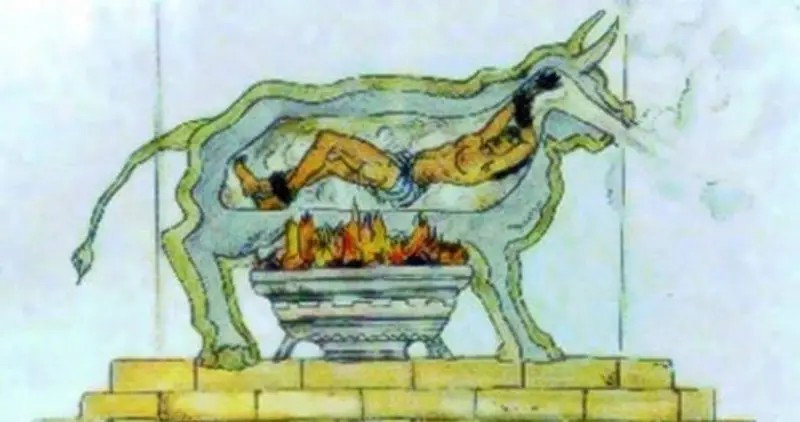
The brazen bull, bronze bull, or Sicilian bull, was allegedly a torture and execution device designed in ancient Greece. According to Diodorus Siculus, recounting the story in Bibliotheca historica, Perillos of Athens invented and proposed it to Phalaris, the tyrant of Akragas, Sicily, as a new means of executing criminals. The bull was said to be made entirely out of bronze, hollow, with a door in one side. According to legends the brazen bull was designed in the form and size of an actual bull and had an acoustic apparatus that converted screams into the sound of a bull. The condemned were locked inside the device, and a fire was set under it, heating the metal until the person inside was roasted to death. Some modern scholars question if the brazen bull ever really existed, attributing reports of the invention to early propaganda.
Lingchi
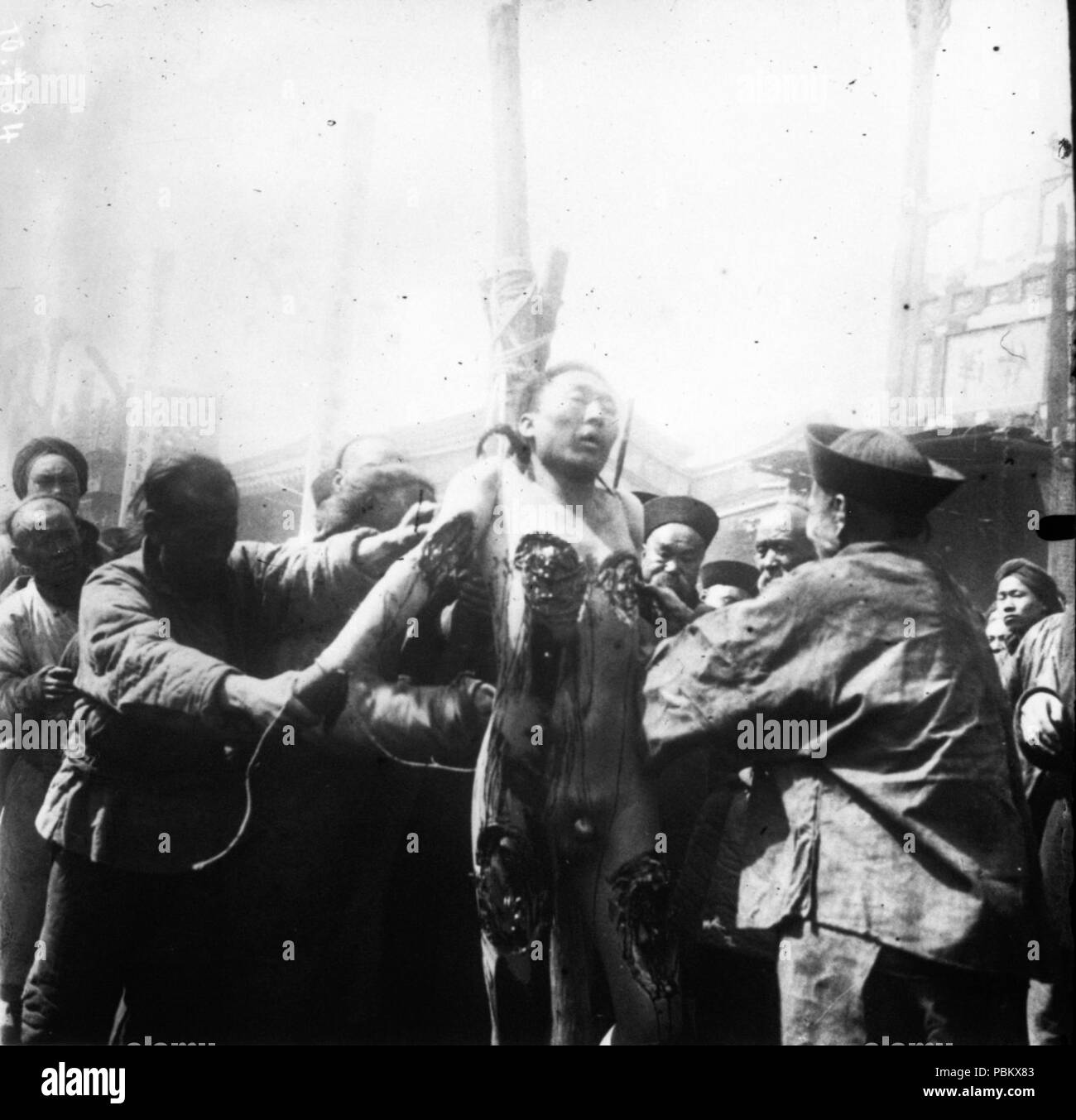
Lingchi (Chinese: 凌遲), translated variously as the slow process, the lingering death, or slow slicing, and also known as death by a thousand cuts, was a form of torture and execution used in China from roughly 900 CE until it was banned in 1905. It was also used in Vietnam. In this form of execution, a knife was used to methodically remove portions of the body over an extended period of time, eventually resulting in death.
Lingchi was reserved for crimes viewed as especially severe, such as treason. Some Westerners were executed in this manner. Even after the practice was outlawed, the concept itself has still appeared across many types of media.
Crucifixion

Crucifixion is a method of capital punishment in which the victim is tied or nailed to a large wooden beam and left to hang, perhaps for several days, until eventual death from exhaustion and asphyxiation.
Breaking Wheel

This is among the most grotesque and horrific of them all. They weren't just placed atop the wheel. The wheel itself was made out of a heavy iron or wood, and would be used by the tortures to slowly break/pulverize the victim's bones until he his body was jelly. They would sometimes drop the wheel from a height of 10+ feet to achieve this. Start at the feet Then the ankles. Up they'd go. Some wheels had large spikes on the outside. Once the victim's bones had been broken so completely their body had no more form they would impale them on these outside spikes, wrapping the body around the wheel, and then roll it down a hill.
Premature Burial
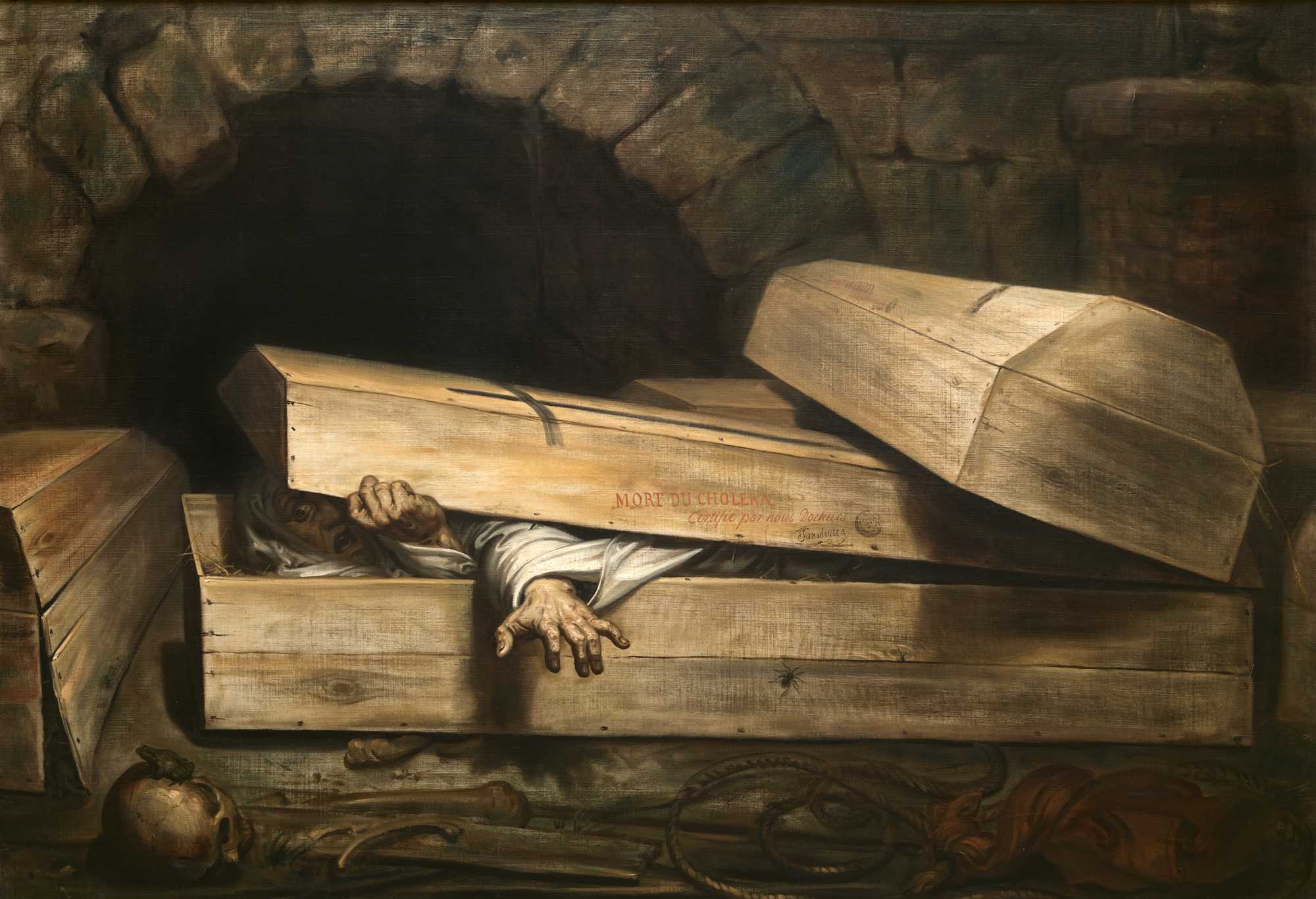
Premature burial, also known as live burial, burial alive, or vivisepulture, means to be buried while still alive.
Animals or humans may be buried alive accidentally on the mistaken assumption that they are dead, or intentionally as a form of torture, murder, or execution. It may also occur with consent of the victim as a part of a stunt, with the intention to escape.
Fear of being buried alive is reported to be among the most common phobias.
Death by Sawing
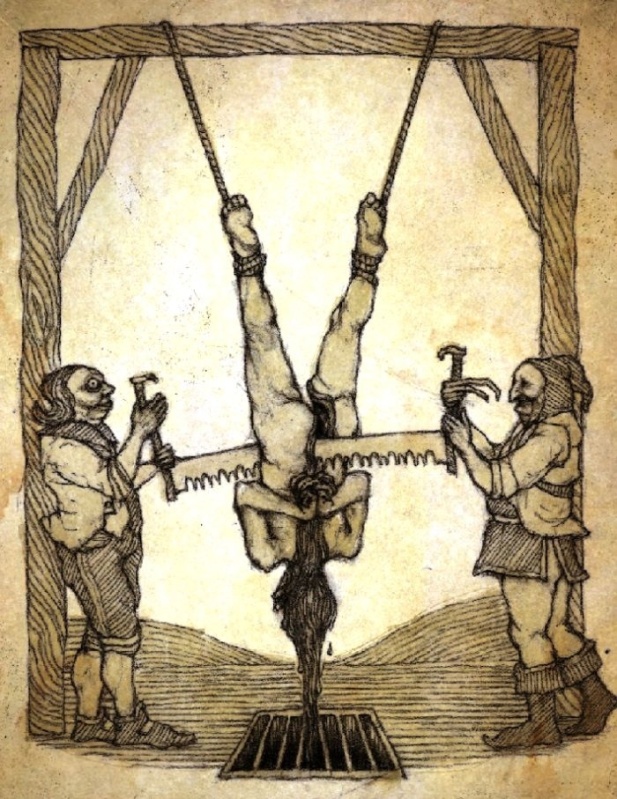
In only one case, in the story about Simon the Zealot, the person is explicitly described as being hung upside-down and sawn apart vertically through the middle, starting at the groin, with no mention of fastening or support boards around the person, in the manner depicted in illustrations. In other cases where details about the method beyond the mere sawing act are explicitly supplied, the condemned person was apparently fastened to either one or two boards prior to sawing.
Boiling To Death

A slow and agonizing punishment, this method traditionally saw the victim gradually lowered — feet-first — into boiling oil, water, or wax (although uses of boiling wine and molten lead have also been recorded).
If the shock of the pain did not render them immediately unconscious, the person would experience the excruciating sensation of their outer layers of skin, utterly destroyed by immersion burns, dissolving right off their body, followed by the complete breakdown of the fatty tissue, boiling away beneath.
It seems safe to assume that such a horrendous fate, one of the worst execution methods ever devised, would be reserved for the foulest of murderers, but historical documents refute this.
The Blood Eagle

A technique ascribed to ancient Norse warriors, the blood eagle mixed brutality and poetic imagery in a way that only the Vikings could. First, the victim’s back would be hacked open and the skin ripped apart, exposing the spinal column.
The ribs would then be snapped from the spine and forcibly bent backwards until they faced outwards from the body, forming a pair of bloody, shattered eagle’s wings. As a horrifying finale, the lungs would then be pulled from the body cavity and coated with stinging salt, causing eventual death by suffocation.
There is some question as to whether this technique was ever actually used as the only accounts come from Norse literature.
Several scholars claim that the act we know of today is simply a result of poor translating, and misunderstands the strong association of the eagle with blood and death in Norse imagery. That said, every account is consistent in that in each case, the victim is a nobleman being punished for murdering his father.
The good news for any poor soul who might have suffered this indignity? The agony and blood loss from the initial wounds would probably have caused them to pass out long before the lungs were removed from their bodies.
Impalement

Most famously used by Vlad the Impaler, 15th-century ruler of Wallachia (in present-day Romania) and inspiration for Count Dracula, the act of impalement has a long, grim history. While images tend to depict people skewered through the midsection and then held aloft — in a manner that would almost certainly bring about a rapid death — the real process was a much longer, horrifically drawn-out ordeal.
Traditionally, the stake would be partially sharpened and planted, point up, in the ground. The victim would then be placed over the spike as it was inserted partway into the rectum or vagina.
As their own body weight dragged them further onto the pole, the semi-greased wooden stake would force its way up through their body, piercing organs with an agonizing slowness as it eventually penetrated the entire torso, finally tearing an exit wound through the skin of the shoulder, neck or throat.
The earliest records of the torture come from 1772 B.C. in Babylon, where King Hammurabi ordered a woman be executed in this way for killing her husband. But its use continued until as recently as the 20th century, when the Ottoman government employed the technique during the Armenian genocide of 1915-1923.
According to some accounts, it could take the victim — exposed, bleeding, and writhing in tormented agony — as long as eight whole days to die.
Keelhauling

Walking the plank might not be the most pleasant of deaths, but it seems moderately more humane than the other favored maritime punishment of keelhauling.
A punishment that often ended in death due to the severity of the wounds sustained (or was simply carried out until the point of death), it saw the victim, legs weighted and suspended from a rope, dropped from the bow of the ship and then rapidly pulled underwater along the length of the hull — and over the keel (the beam that runs longitudinally down the center of the underside of the ship), hence the name — to the stern.
In the age of wooden sailing ships, the hull of a vessel would normally be coated in a thick layer of barnacles, whose shells could be rock hard and razor sharp.
As the drowning sailor was yanked relentlessly through the salt water, these protrusions would strip the skin from his body, gouging out raw chunks of flesh and even, by some accounts, tearing off whole limbs or severing the head.
If the sailor was still alive, they might be hung from the mast for 15 minutes before going in again. In some cases, the victim would have an oil-soaked sponge — containing a breath of air — stuffed into their mouth to prevent a “merciful” drowning.
Employed mostly by the Dutch and the French from the 1500s until it was abolished in 1853, accounts of its use date back as far as Greece in 800 B.C.
The Roman Candle

Many of the very worst execution methods ever devised involve fire — from burning witches at the stake in medieval Britain to roasting criminals alive in the searing metal insides of the brazen bull in Ancient Greece — but few match the sheer lack of humanity as the Roman Candle.
A rumored favorite of the mad Roman Emperor Nero, this method saw the subject tied to a stake and smeared with flammable pitch (tree or plant resin), then set ablaze, slowly burning to death from the feet up.
What sets this above the many other similar methods is the fact that the victims were sometimes lined up outside to provide the lighting for one of Nero’s evening parties.
Being Hanged, Drawn, And Quartered

First recorded in England during the 13th century, this unusually extreme — even for the time — mode of execution was made the statutory punishment for treason in 1351. Though it was intended to be an act of such barbarous severity that no one would ever risk committing a treasonous act, there were nevertheless plenty of recipients over the next 500 years.
The process of being hanged, drawn and quartered began with the victim being dragged to the site of execution while strapped to a wooden panel, which was in turn tied to a horse.
They would then experience a slow hanging, in which, rather than being dropped to the traditional quick death of a broken neck, they would instead be left to choke horribly as the rope tore up the skin of their throat, their body weight dragging them downwards.
Some had the good fortune to die at this stage, including infamous Gunpowder Plot conspirator Guy Fawkes, who ensured a faster death by leaping from the gallows.
Once half strangled, the drawing would begin. The victim would be strapped down and then slowly disemboweled, their stomachs sliced open and their intestines and other major organs hacked apart and pulled — “drawn” — from the body.
The genitals would often be mutilated and ripped from between their legs. Those unlucky enough to still be alive at this point might witness their organs burned in front of them, before they were finally decapitated.
Once death had finally claimed them, the recipient’s body would be carved into four pieces — or “quartered” — and the parts sent to prominent areas of the country as a warning to others.
The head would often be taken to the infamous Tower of London, where it would be impaled on a spike and placed on the walls, “for the mockery of London.”
Rat Torture

As recently depicted in Game Of Thrones, rat torture is a method ingenious in its disgusting simplicity. In its most basic form, a bucket containing live rats is placed on the exposed torso of the victim, and heat applied to the base of the bucket.
The rats, crazy with fear from the heat, tear and gnaw their way into the abdomen of the victim, clawing and ripping through skin, flesh, organs, and intestines in their quest to escape.
Possessing the most powerful biting and chewing motion of any rodent, rats are able to make short work of a human stomach. Along with the unimaginable pain, the victim would also suffer the sick horror of feeling the large, filthy creatures writhing around inside their guts as they died.
While associated with Elizabethan England — where the Tower of London was said to have housed a “Dungeon of Rats,” a pitch black room below high water mark that would draw in rats from the River Thames to torment the room’s inhabitants — the practice has been used far more recently.
General Pinochet is said to have employed the technique during his dictatorship of Chile (1973-1990), while reports from Argentina during the National Reorganization Process in the late 1970s and early ’80s claimed victims were subjected to a version in which live rats — or sometimes spiders — were inserted into the subject’s body via a tube in the rectum or vagina.
Bamboo Torture

Forcing thin shards of bamboo under the fingernails has long been cited as an interrogation method, but bamboo has been used to creatively — and slowly — execute a person, too. Allegedly used by the Japanese on American prisoners of war, it saw the victim tied down to a frame over a patch of newly sprouting bamboo plants.
One of the fastest-growing plants in the world, capable of up to three feet of growth in 24 hours, the sharp-tipped plants would slowly pierce the skin of the victim — and then continue to grow. The end result was death by gradual, continuous, multiple impalements, the equivalent of being dropped on a bed of sharpened stakes in terrible slow motion.
Despite the practice having roots in the former areas of Ceylon (now Sri Lanka) and Siam (now Thailand) in the 19th century, there are no proven instances of it having been used during WWII.
It’s certainly possible, however, and it has been shown that the technique, among the worst execution methods ever, works: A 2008 episode of MythBusters found that bamboo was capable of penetrating a human-sized lump of ballistic gelatin over the course of three days.
Flaying

Flaying — better known as “skinning alive” — has a long and grotesque history. Records of the practice exist as far back as the Neo-Assyrian Empire (beginning in 911 B.C.), but it has cropped up in most civilizations at one time or another, including Medieval Europe (where it tended to be used as a punishment for traitors) and in the ritual human sacrifices made by the Aztecs in Mexico (the Aztecs, at least, are believed to have skinned the body after the sacrifice had been made).
Various techniques have been utilized in the many different cultures in which flaying has been employed, but the basis remains the same: Slowly, excruciatingly slicing the skin from the body while keeping the victim alive for as long as possible (and when feasible, removing the skin intact).
Carvings from the Assyrian period show the process beginning with incisions to the thighs or buttocks, while the European method — pictured above — shows it starting with the skin being torn from the feet and lower legs. Chinese Emperors Sun Hao, Fu Sheng, and Gao Heng ordered the skin to be peeled from their victims’ faces.
Death would normally come as a result of massive blood loss and shock, but in the unfortunate cases where expert flayers were used, the victim could be kept alive in a state of perpetual agony for several days before finally succumbing to their hopelessly infected wounds.
Scaphism

For sheer, delirious, nauseating horror, scaphism may be one of the worst execution methods ever devised. Practiced by the Ancient Persians, starting around 500 B.C., it saw the victim placed inside a hollowed-out log or narrow boat, their hands and feet tied to each end.
The victim was then forced to ingest a mixture of milk and honey until they uncontrollably voided their bowels, at which point their skin was smeared with more milk and honey before they were left exposed in the sun and surrounded by their own feces and vomit.
It was at this point that the insects would descend. Stinging and biting insects like wasps and ants would torture the victim, but worse, others would crawl inside the unprotected orifices of the subject and lay eggs, eating them alive from the inside out.
With the ration of milk and honey — and sometimes water — repeated at daily intervals, the victim had little chance of dying of thirst or hunger.
Instead, they succumbed to tortured madness, experiencing the agonizing, nightmare crawl of thousands of insects on their skin, burrowing into their eyes and ears and nose, filling their mouths, while worms and parasites bred in the filth at the bottom of the boat and squirmed up into their bowels.
Death would eventually be caused by a combination of exposure and the massive infections caused by both the insects, and the fecal matter smeared into the wounds. One account of such an execution by the Greek historian Plutarch claimed that it took the victim 17 whole days to die.
Brazen Bull

The brazen bull, bronze bull, or Sicilian bull, was allegedly a torture and execution device designed in ancient Greece. According to Diodorus Siculus, recounting the story in Bibliotheca historica, Perillos of Athens invented and proposed it to Phalaris, the tyrant of Akragas, Sicily, as a new means of executing criminals. The bull was said to be made entirely out of bronze, hollow, with a door in one side. According to legends the brazen bull was designed in the form and size of an actual bull and had an acoustic apparatus that converted screams into the sound of a bull. The condemned were locked inside the device, and a fire was set under it, heating the metal until the person inside was roasted to death. Some modern scholars question if the brazen bull ever really existed, attributing reports of the invention to early propaganda.
Lingchi

Lingchi (Chinese: 凌遲), translated variously as the slow process, the lingering death, or slow slicing, and also known as death by a thousand cuts, was a form of torture and execution used in China from roughly 900 CE until it was banned in 1905. It was also used in Vietnam. In this form of execution, a knife was used to methodically remove portions of the body over an extended period of time, eventually resulting in death.
Lingchi was reserved for crimes viewed as especially severe, such as treason. Some Westerners were executed in this manner. Even after the practice was outlawed, the concept itself has still appeared across many types of media.
Crucifixion

Crucifixion is a method of capital punishment in which the victim is tied or nailed to a large wooden beam and left to hang, perhaps for several days, until eventual death from exhaustion and asphyxiation.
Breaking Wheel

This is among the most grotesque and horrific of them all. They weren't just placed atop the wheel. The wheel itself was made out of a heavy iron or wood, and would be used by the tortures to slowly break/pulverize the victim's bones until he his body was jelly. They would sometimes drop the wheel from a height of 10+ feet to achieve this. Start at the feet Then the ankles. Up they'd go. Some wheels had large spikes on the outside. Once the victim's bones had been broken so completely their body had no more form they would impale them on these outside spikes, wrapping the body around the wheel, and then roll it down a hill.
Premature Burial

Premature burial, also known as live burial, burial alive, or vivisepulture, means to be buried while still alive.
Animals or humans may be buried alive accidentally on the mistaken assumption that they are dead, or intentionally as a form of torture, murder, or execution. It may also occur with consent of the victim as a part of a stunt, with the intention to escape.
Fear of being buried alive is reported to be among the most common phobias.
Death by Sawing

In only one case, in the story about Simon the Zealot, the person is explicitly described as being hung upside-down and sawn apart vertically through the middle, starting at the groin, with no mention of fastening or support boards around the person, in the manner depicted in illustrations. In other cases where details about the method beyond the mere sawing act are explicitly supplied, the condemned person was apparently fastened to either one or two boards prior to sawing.
Last edited:



